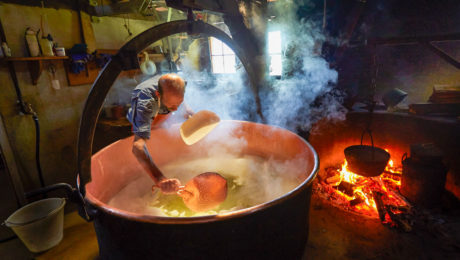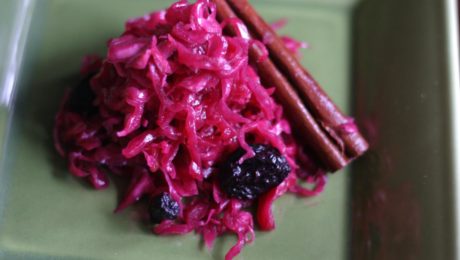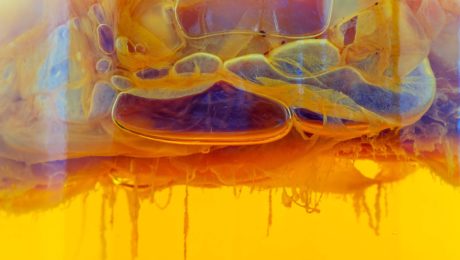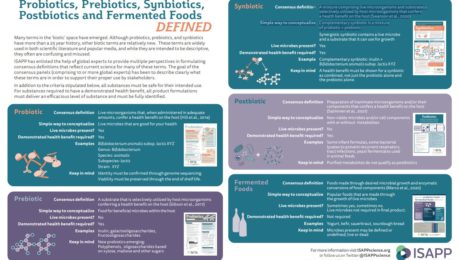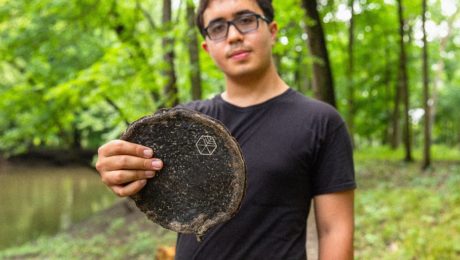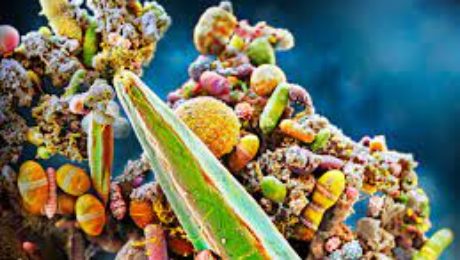Gut Microbes Key to Exercise Motivation
A new study published in Nature reveals some new insight into the gut-to-brain pathway. Certain bacteria types boost our desire to exercise.
The study, performed on mice by researchers at the University of Pennsylvania, found differences in running performance based on the presence of gut bacterial species Eubacterium rectale and Coprococcus eutactus in the higher-performing mice. The metabolites known as fatty acid amides that the bacteria produce stimulate the sensory nerves in the gut, enhancing activity in the motivation-controlling region of the brain.
“If we can confirm the presence of a similar pathway in humans, it could offer an effective way to boost people’s levels of exercise to improve public health generally,” says Christoph Thaiss, PhD, an assistant professor of microbiology at Penn Medicine and a senior study author.
Researchers were surprised to find genetics accounted for only a small portion of performance differences in the mice. Gut bacterial populations were “substantially more important,” reads the study. Giving the mice antibiotics to get rid of their gut bacteria reduced the mice’s running performance by half.
“This gut-to-brain motivation pathway might have evolved to connect nutrient availability and the state of the gut bacterial population to the readiness to engage in prolonged physical activity,” says J. Nicholas Betley, PhD, an associate professor of Biology at the University of Pennsylvania’s School of Arts and Sciences and a study author. “This line of research could develop into a whole new branch of exercise physiology.”
Read more (Science Daily)
Domesticating Fermented Food Microbes
Humans have domesticated plants and animals since the early days of civilization, changing the life cycles, appearances and behaviors of crops and livestock. A new study shows humans have done the same to fermented products, selectively taming microbes. But as a result, microbial strains have evolved to where they can no longer survive in the wild.
“The burst of flavor from summer’s first sweet corn and the proud stance of a show dog both testify to the power of domestication,” reads an article in Science titled “Humans tamed the microbes behind cheese, soy, and more.” “But so does the microbial alchemy that turns milk into cheese, grain into bread, and soy into miso. Like the ancestors of the corn and the dog, the fungi and bacteria that drive these transformations were modified for human use. And their genomes have acquired many of the classic signatures of domestication.”
Humans have used selective breeding to produce the most desired traits in plants and animals – for example, making a plant less bitter or an animal larger. Thousands of years of domestication have changed DNA. Though microbes can’t be bred the same way, “humans can grow microbes and select variants that best serve our purposes.” It’s now left “genetic hallmarks similar to those in domesticated plants and animals: The microbes have lost genes, evolved into new species or strains and become unable to thrive in the wild.”
Scientists shared this research during two talks at Microbe 2022, the annual meeting of the American Society for Microbiology in Washington D.C. The talks – “Origins and Consequences of Microbial Strain Diversity” and “Microbial Diversity in Food Systems: From Farm to Fork”
– were convened by TFA Advisory Board members Benjamin Wolfe, PhD, ofTufts University, and Josephine Wee, PhD, from Penn State. They invited various academics to present their research on these topics.
Microbial Domestication in Cheese
Wolfe said the studies “are getting to the mechanisms” of how microbial domestication works. They reveal “which genes are key to microbes’ prized traits – and which can be lost,” continues the Science article. This work is critical to the future of food, as these microbe gene traits can shape fermented foods and beverages.
Presenters included Vincent Somerville, PhD, from the University of Lausanne, Switzerland, speaking on the changing genomic structure of cheese cultures. He pointed out that bread yeasts have long been domesticated. They’ve lost so much of their genetic variation that they can’t live in the wild. Other microbes are “lacking clear evidence of domestication … in part because [their] microbial communities can be hard to study,” he said.
Somerville’s research revolves around a starter culture for a Swiss hard cheese. Bacterial cheese starters were created by early cheesemakers; in the 70s, samples of these cultures began being banked to ensure quality. But Somerville and his collaborators, after sequencing the genomes of more than 100 of these samples, found little genetic diversity, with just a few strains of two dominant species..
“The exciting thing from this work was having samples over time,” Wolfe said. “You can see the shaping of diversity,” with changes in the past 50 years hinting at the trajectory of change over past centuries.
Domesticated vs. Wild Aspergillus
John Gibbons, a genomicist at the University of Massachusetts, Amherst, presented on Aspergillus oryzae, “the fungus that jump-starts production of sake from rice, and soy sauce and miso from soybeans.” Farmers cultivate A. oryzae, which reproduces on its own. “But when humans take a little finished sake and transfer it to a rice mash to begin fermentation anew, they also transfer cells of the fungal strains that evolved and survived best during the first round of fermentation,” the article reads.
Gibbons compared the genomes of A. oryzae strains with those of A. flavus, it’s wild ancestor. Human involvement in transferring the fungus has “boosted A. oryzae’s ability to break down starches and to tolerate the alcohol produced by fermentation.” The domesticated Aspergillus strains may have up to five times the number of genes used to break down starches compared to their ancestors.
“The restructuring of metabolism appears to be a hallmark of domestication in fungi,” he said.
Gibbons also found the genes of domesticated A. oryzae to have little variation. And some key genes have disappeared, “including those for toxins that would kill the yeast needed to complete fermentation — and which can make humans sick.” The article concludes: “Domestication has apparently made A. oryzae more human friendly, just as it bred bitter flavors out of many food plants.”
- Published in Science
Life on Mars, Thanks to Kombucha
For decades, scientists and astronauts have studied if living on Mars is feasible. The harsh environment on the planet suggests few – if any – living things can survive. But new research has revealed something interesting: kombucha can survive in extraterrestrial conditions.
Scientists found the bacteria in a kombucha SCOBY, Komagataeibacter, can survive on Mars. The research, part of the Biology and Mars Experiment (BIOMEX), began in 2014, when kombucha cultures were sent to the International Space Station. Scientists hoped cellulose, “the genomic architecture of kombucha” could survive in space, and Komagataeibacter produces cellulose.
“Based on our metagenomic analysis, we found that the simulated Martian environment drastically disrupted the microbial ecology of kombucha cultures,” said Bertram Brenig, professor at University of Göttingen’s Institute of Veterinary Medicineand head of the study . “However, we were surprised to discover that the cellulose-producing bacteria of the genus Komagataeibacter survived.”
The cultures lived eighteen months outside the ISS, were reactivated on earth and cultivated for another two and a half years.
The study, published in Frontiers in Microbiology, “provides the first evidence that bacterial cellulose could be a biomarker for extraterrestrial life and cellulose-based membranes or films could be a good biomaterial for protecting life and producing consumer goods in extraterrestrial settlements.”
Read more (University of Göttingen)
- Published in Science
“Bacterial Bully” Could Create Healthier & Tastier Fermented Foods
Microbiologists have long considered that there are two distinct categories of energy conservation in microorganisms: fermentation and respiration. Lactic acid bacteria (LAB) use fermentation, making it central to food and drink production and preservation since the dawn of man.
But researchers at the University of California, Davis, and Rice University discovered a LAB species that uses a hybrid metabolism, combining both fermentation and respiration.
“These are two very different things, to the extent that we classify bacteria as basically one or the other,” said Caroline Ajo-Franklin, a bioscientist at Rice University and co-author of the study. “There are examples of bacteria that can do both, but that’s like saying I can ride a bicycle or I can drive a car. You never do both at the same time.”
“What we discovered is a LAB that blends the two, like an organism that’s not warm- or cold-blooded but has features of both,” she said. “That’s the big surprise, because we didn’t know it was possible for an organism to blend these two distinct metabolisms.”
The species — lactiplantibacillus plantarum — is what scientists call a bacterial bully because it takes advantage of two distinct metabolic processes, according to a press release from Rice on the study. These systems were “not previously known to coexist to acquire the fuel they burn for energy.”
“Using this blended metabolism, lactic acid bacteria like L. plantarum grow better and do a faster job acidifying its environment,” said Maria Marco, a professor in the food science and technology department at UC Davis and the study’s co-author [and a TFA Science Advisor].
The discovery is significant for food and chemical production. New technologies that use LAB could now produce healthier and tastier ferments, minimize food waste and change the flavors and textures of fermented food.
“We may also find that this blended metabolism has benefits in other habitats, such as the digestive tract,” Marco said. “The ability to manipulate it could improve gut health.”
The study began with a puzzle: the realization that genes responsible for the electron transfer pathway in mainly respiratory organisms also appear in the LAB genome. “It was like finding the metabolic genes for a snake in a whale,” Ajo-Franklin said. “It didn’t make a lot of sense, and we thought, ‘We’ve got to figure this out.’”
While the Davis lab studied the genome, the team at Rice carried out fermentation experiments on kale.
“It wasn’t our first choice,” said Rice alumna and co-lead author Sara Tejedor-Sanz (now a senior scientific engineer in the Advanced Biofuels and Bioproducts Process Development Unit at Lawrence Berkeley National Lab).
“We performed some initial experiments with cabbage, since that’s a known fermented food — sauerkraut and kimchi — in which lactic acid bacteria are present,” she said. “But there were technical difficulties and it didn’t turn out so well. So we looked for another food to ferment where LAB could be found in its ecological niches.
“Kale has compounds like vitamins and quinones that lactic acid bacteria use as cofactors in their metabolism, and are also involved in interacting with the electrodes,” she said. “We also found fermenting kale to make juice was a trend. It sounded perfect for our biochemical reactors.”
The study showed LAB enhances metabolism through a FLavin-based Extracellular Electron Transfer (FLEET) pathway that expresses two genes (ndh-2 and pp1A) associated with iron reduction, a step in the process of stripping and incorporating electrons into ATP (adenosine triphosphate (ATP), energy-carrying molecule).
Because LAB’s genome has evolved to be small, thus requiring less energy to maintain, the wide conservation of FLEET must serve a purpose, Ajo-Franklin said.
“Our hypothesis is this helps bacteria get established in new environments,” she said. “It’s a way to kick-start their metabolisms and outcompete their neighbors by changing the environment to be more acidic. It’s being a bully.”
That the FLEET pathway can be triggered with electrodes offers many possibilities, she said. “We found we can use the hybrid metabolism in food fermentation,” Ajo-Franklin said. “Now we have a way to change how food may taste and avoid failed food fermentations by using electronics.”
“We may also find that this blended metabolism has benefits in other habitats, such as the digestive tract,” Marco said. “The ability to manipulate it could improve gut health.”
Ajo-Franklin noted LAB are commonly found in the microbiomes of many organisms, including humans. “You can already buy it in health food stores as a probiotic,” she said. “The human gut is an anaerobic environment, so LAB have to keep a redox balance. If it oxidizes carbon to gain energy, it has to figure out a way to reduce carbon somewhere else.
“Now we think if we provide another electron donor or acceptor, we could promote the growth of positive bacteria over negative bacteria.”
UC Davis graduate student Eric Stevens is co-lead author of the study. Co-authors are Rice graduate student Siliang Li; at UC Davis, graduate students Peter Finnegan and James Nelson, and Andre Knoesen, a professor of electrical and computer engineering, at UC Davis; and Samuel Light, the Neubauer Family Assistant Professor of Microbiology at the University of Chicago.
Ajo-Franklin is a professor of biosciences and a CPRIT Scholar. Marco is a professor of food science and technology.
The National Science Foundation, Office of Naval Research, the Department of Energy Office of Basic Energy Sciences and a Rodgers University fellowship supported the research.
The study results were published in the journal eLife.
- Published in Food & Flavor, Health, Science
SCOBY as Water Filter?
Can you use bacteria to eliminate bacteria? Commercial water filters remove contaminants from water, but the pores eventually clog, causing water to filter more slowly. Now researchers are studying a living membrane to filter water: a kombucha SCOBY.
Researchers at Montana Technological University (MTU) and Arizona State University (ASU) found the films of cellulose that make up a SCOBY are 19-40% more effective than commercial filtration systems at preventing the formation of bacterial biofilms. The SCOBY filter also maintained a fast rate of filtration for a longer period of time. Though a biofilm did eventually form on top of the SCOBY, it contained fewer bacteria than in a commercial filter.
“The scientists couldn’t use the wild yeasts typically used in kombucha because the yeasts are difficult to modify genetically,” reads an article in Wired. “Instead, the researchers used lab-grown yeast, specifically a strain called Saccharomyces cerevisiae, or brewer’s yeast. They combined the brewer’s yeast with a bacteria called Komagataeibacter rhaeticus (which can create a lot of cellulose) to create their ‘mother’ SCOBY.”
Researchers engineered the cells in the yeast to produce glow-in-the-dark enzymes, which sense pollutants and break them down. SCOBY-based filters are not only inexpensive to make, they biodegrade when discarded.
Their research was published in the American Chemical Society journal ACS ES&T Water.
Read more (Wired)
The Rise of Fermented Foods and -Biotics
Microbes on our bodies outnumber our human cells. Can we improve our health using microbes?
“(Humans) are minuscule compared to the genetic content of our microbiomes,” says Maria Marco, PhD, professor of food science at the University of California, Davis (and a TFA Advisory Board Member). “We now have a much better handle that microbes are good for us.”
Marco was a featured speaker at an Institute for the Advancement of Food and Nutrition Sciences (IAFNS) webinar, “What’s What?! Probiotics, Postbiotics, Prebiotics, Synbiotics and Fermented Foods.” Also speaking was Karen Scott, PhD, professor at University of Aberdeen, Scotland, and co-director of the university’s Centre for Bacteria in Health and Disease.
While probiotic-containing foods and supplements have been around for decades – or, in the case of fermented foods, tens of thousands of years – they have become more common recently . But “as the terms relevant to this space proliferate, so does confusion,” states IAFNS.
Using definitions created by the International Scientific Association for Postbiotics and Prebiotics (ISAPP), Marco and Scott presented the attributes of fermented foods, probiotics, prebiotics, synbiotics and postbiotics.
The majority of microbes in the human body are in the digestive tract, Marco notes: “We have frankly very few ways we can direct them towards what we need for sustaining our health and well being.” Humans can’t control age or genetics and have little impact over environmental factors.
What we can control, though, are the kinds of foods, beverages and supplements we consume.
Fermented Foods
It’s estimated that one third of the human diet globally is made up of fermented foods. But this is a diverse category that shares one common element: “Fermented foods are made by microbes,” Marco adds. “You can’t have a fermented food without a microbe.”
This distinction separates true fermented foods from those that look fermented but don’t have microbes involved. Quick pickles or cucumbers soaked in a vinegar brine, for example, are not fermented. And there are fermented foods that originally contained live microbes, but where those microbes are killed during production — in sourdough bread, shelf-stable pickles and veggies, sausage, soy sauce, vinegar, wine, most beers, coffee and chocolate. Fermented foods that contain live, viable microbes include yogurt, kefir, most cheeses, natto, tempeh, kimchi, dry fermented sausages, most kombuchas and some beers.
“There’s confusion among scientists and the public about what is a fermented food,” Marco says.
Fermented foods provide health benefits by transforming food ingredients, synthesizing nutrients and providing live microbes.There is some evidence they aid digestive health (kefir, sourdough), improve mood and behavior (wine, beer, coffee), reduce inflammatory bowel syndrome (sauerkraut, sourdough), aid weight loss and fight obesity (yogurt, kimchi), and enhance immunity (kimchi, yogurt), bone health (yogurt, kefir, natto) and the cardiovascular system (yogurt, cheese, coffee, wine, beer, vinegar). But there are only a few studies on humans that have examined these topics. More studies of fermented foods are needed to document and prove these benefits.
Probiotics
Probiotics, on the other hand, have clinical evidence documenting their health benefits. “We know probiotics improve human health,” Marco says.
The concept of probiotics dates back to the early 20th century, but the word “probiotic” has now become a household term. Most scientific studies involving probiotics look at their benefit to the digestive tract, but new research is examining their impact on the respiratory system and in aiding vaginal health.
Probiotics are different from fermented foods because they are defined at the strain level and their genomic sequence is known, Marco adds. Probiotics should be alive at the time of consumption in order to provide a health benefit.
Postbiotics
Postbiotics are dead microorganisms. It is a relatively new term — also referred to as parabiotics, non-viable probiotics, heat-killed probiotics and tyndallized probiotics — and there’s emerging research around the health benefits of consuming these inanimate cells.
“I think we’ll be seeing a lot more attention to this concept as we begin to understand how probiotics work and gut microbiomes work and the specific compounds needed to modulate our health,” according to Marco.
Prebiotics
Prebiotics are, according to ISAPP, “A substrate selectively utilized by host microorganisms conferring a health benefit on the host.”
“It basically means a food source for microorganisms that live in or on a source,” Scott says. “But any candidate for a prebiotic must confer a health benefit.”
Prebiotics are not processed in the small intestine. They reach the large intestine undigested, where they serve as nutrients for beneficial microorganisms in our gut microbiome.
Synbiotics
Synbiotics are mixtures of probiotics and prebiotics and stimulate a host’s resident bacteria. They are composed of live microorganisms and substrates that demonstrate a health benefit when combined.
Scott notes that, in human trials with probiotics, none of the currently recognized probiotic species (like lactobacilli and bifidobacteria) appear in fecal samples existing probiotics.
“There must be something missing in what we’re doing in this field,” she says. “We need new probiotics. I’m not saying existing probiotics don’t work or we shouldn’t use them. But I think that now that we have the potential to develop new probiotics, they might be even better than what we have now.”
She sees great potential in this new class of -biotics.
Both Scott and Marco encouraged nutritionists to work with clients on first improving their diets before adding supplements. The -biotics stimulate what’s in the gut, so a diverse diet is the best starting point.
Wood Alternative from Kombucha Waste
A new wood alternative made from a byproduct of kombucha brewing waste won this year’s James Dyson Award, which celebrates problem-solving design. The material, called Pyrus, was invented by sustainable-design student Gabe Tavas. Tavas’ company, Symmetry, makes small items from Pyrus that replicate exotic woods like mahogany or purpleheart (two wood types found in the rainforest and endangered by aggressive deforestation).
Tavas was inspired to create Pyrus after seeing designers use kombucha bacterial cellulose (the film that grows on top of the beverage during brewing) in various projects. Tavas was struck by the fact that trees are made from cellulose, and he began experimenting in his dorm room with the waste from his own kombucha brewing. He eventually partnered with local Chicago producer, KombuchAde, which supplies Tavas with 250 pounds of cellulose a day.
Pyrus is made by pouring cellulose into a mold, adding agar (an algae-based binding gel), and then dehydrating and compressing it. The synthetic wood can be sanded and cut, but will decompose in contact with water.
Read more (Fast Company)
The Fermentation-Flavor Connection in Chocolate
Cacao would never obtain its rich flavor profile without a traditional food processing technique: fermentation.
“I feel like fermentation adds about three-quarters of the flavor to the finished chocolate. I think it is the most important step in the entire tree-to-bar process for the flavor of the chocolate, and the chocolate makers have been taking too much credit for the flavor of their chocolate,” says Nat Bletter, PhD and founder of Madre Chocolate.
Chocolate makers “can definitely take a great grown and fermented cacao and make it shine, but it’s really hard to take a badly grown and fermented cacao and make a good tasting chocolate and that’s why so much of the world’s chocolate is loaded with milk and sugar to try to cover up some of the bad fermentation flavors.”
Bletter joined Max Wax (vice president of Rizek Cacao) and Dan O’Doherty (principal of Cacao Services) in sharing their expertise during a joint webinar, The Fermentation-Flavor Connection in Chocolate., co-hosted byThe Fine Chocolate Industry Association and The Fermentation Association..
The three speakers work in different size chocolate operations. Madre Chocolate is a small-scale chocolate making company in Honolulu that uses cacao from small Hawaiian farmers; Rizek Cacao is a producer and exporter of cacao and cacao products based in the Dominican Republic; and Cacao Services (also in Honolulu) s an agricultural and scientific consulting company that specifically focuses on cacao production systems.
Complex fermentation
Cacao fermentation is among the most complex of food ferments because it utilizes three families of microbes and 5-10 species in each. “It is a little bit hard to control since it’s not just one single species of microbes that you’re trying to support a good ecosystem,” Bletter adds.
Wax attributes less of chocolate’s flavor to fermentation. He says there are flavors produced by the metabolism of the plant itself, “so genetics is probably No. 1, then comes the terroir that comes with fermentation. We shouldn’t be dogmatic on fermentation but on the contrary open to this fantastic dialogue between wisdom and science.”
A chocolate maker is responsible for studying the effects of yeasts on their cacao ferment, Wax adds. They should ask: How does the naturally occurring yeast change flavor? What’s the metabolism rate? Is there a possibility of naturally inoculating the cacao for a different flavor?
“It is absolutely true that you should not inoculate something using either commercial yeast or yeast from grapes or other types of culture, or even from different environments,” Wax says. “But it is also true that the variety of yeast that is naturally occurring, not all of them give the same taste profile. … Nobody wants the same flavor and the same cacao forever, just as we don’t want the same wine or the same cheese or the same yogurt or the same beer.”
Rizek Cacao employs 32 varieties of yeast in their chocolate.
Sensory Cues
O’Doherty, who works with cacao farmers, says it’s possible to ferment cacao without any kind of quantitative measuring devices.
“If you’re an experienced fermenter and you really know what you’re looking at, you use all your senses,” O’Doherty says. A fermented cacao bean will be plump and juicy; the color will be reddish-brown (a pale bean is under-fermented) and the bean’s scent will change depending on the stage of the fermentation process.
“If I only had one sense to go on for cacao fermentation, I think it really would be aroma,” O’Doherty continues. The scent sequence will begin as fresh and fruity, transition to a strong yeast fragrance, next to wine , then to ethanol and, finally, the sharp vinegar scent will fade to a fruity vinegar.
One of the topics mostly frequently raised by cacao producers, says O’Doherty,is how to modernize their operations. He points out that most cacao farmers still ferment using boxes and heaps.
“In general, cacao cultivation and processing is centuries behind,” he says. Most cacao farms are run by small shareholders who don’t have the money for barrels or stainless steel equipment. “Sophisticated fermentation vessels are not really an option for consideration. Truth be told, well executed, both heaps and wooden box fermentations can produce some absolutely fantastic cacao.”
O’Doherty concludes: “The larger question about commodity cacao and the incentives or lack thereof is the reason that I have a job helping farmers with fermentation. Although there may be traditions, there’s no feedback mechanism. There is no incentive for good quality and, typically, there’s really not a penalty for bad quality, unless it is actually decomposing…a lot of the work I do is linking these producers that I assist with their harvest and process to chocolate makers that will pay double or triple the typical commodity price. I still don’t think that’s enough but it’s moving the needle in the right direction.”
- Published in Food & Flavor
Can Gut Microbes Fight Viruses?
An estimated 40 trillion microbes make up our gut microbiome. Researchers are now studying how these microbes protect our immune system, fighting off viruses like Covid-19.
“Imagine microbes that block a virus from entering a cell or communicate with the cell and make it a less desirable place for the virus to set up residence,” says Mark Kaplan, chair of the department of microbiology and immunology at the Indiana University School of Medicine. “Manipulating those lines of communication might give us an arsenal to help your body fight the virus more effectively.”
These microbes, according to an article in National Geographic, may fight viruses in one of three ways: “building a wall that blocks invaders, deploying advanced weaponry and providing support to the immune system.” Kaplan calls intestinal bacteria “the gatekeepers between what we eat and our body.”
The article details the new, innovative measures medical professionals are taking to repair a patient’s damaged gut microbiome — transplanting fecal matter, administering a bacteria-targeting virus and pills that release antiviral interferons. But the most compelling way may be consuming a diet rich in fermented foods — the article notes a consensus among medical and science professionals that fermented foods can promote a healthy microbiome.
Read more (National Geographic)
The State of the Art in Coffee Fermentation
More specialty coffee producers are developing unique approaches to their coffee bean fermentation, isolating native microorganisms to create a flavorful cup or working closely with rural farmers to utilize fermentation control techniques on small-scale operations.
“Practically all the coffee we drink has been fermented in one way or another. But there is huge room for improvement, innovation and development in the realm of coffee fermentation,” says Mario Fernández, PhD, Technical Officer with the Specialty Coffee Association (SCA). The SCA partnered with The Fermentation Association for the webinar The State of the Art in Coffee Fermentation.
Fernández continues: “Coffee is produced by millions of small coffee producers around the tropics that have very little capital to invest in fermentation equipment. Oftentimes, the price is too low for them to add fermentation controls as part of the cost equation. Therefore, for perhaps 99.9% of coffee in the world, it undergoes wild fermentation, in which the microbes grow on the mass of mucilage in a wild fashion and the coffee producer only controls certain parameters, such as the length of the fermentation.”
Two industry experts on the forefront of coffee fermentation technique and technology joined Fernández — Felipe Ospina, CEO of Colors of Nature Group (multinational specialty coffee trader) and Rubén Sorto, CEO of BioFortune Group (a coffee, upcycled and food ingredient manufacturer based in Honduras).
Post Harvest Processing Technology
Sorto is adapting fermentation technology to coffee, mapping the microbiota of the bacteria and yeasts that are present at Biofortune Group’s farms.
“We realized that fermentation was one of the key aspects of the coffee production that hadn’t been addressed,” Sorto said, noting fermentation is controlled in industries like dairy, wine, beer and bread but not in coffee. “We learned that our soil, our water, our coffee trees, our leaves, our [coffee] cherries, had a large compendium of bacteria and yeast that were involved in the posterior fermentation process…some of the yeasts and bacteria were definitely beneficial and were urgently needed during the fermentation but some of them were not.”
To maximize flavor, they focus on that complex array of bacteria and yeasts, preferably indigenous to the countries of origin. These microorganisms thrive in their local environment, reflecting altitude and temperature. To control the fermentation of those bacteria and yeasts, Biofortune reduces the variables, including monitoring pH levels, alcohol content and container contaminants.
“If you are able to control the fermentation, you are also able to offer a higher-quality product, a consistent quality product…and that’s what the market is looking for, consistent quality in a cup,” Sorto says.
Educating Coffee Farmers
Ospina, meanwhile, is researching fermentation techniques accessible to small-holder coffee producers and training them. The goal is for them to understand the role of each microorganism, discover how to use it in fermentation, then scale that knowledge to small-scale operations, so they can produce incredible coffees.
At La Cereza Research Center, the Colors of Nature facility in southern Colombia, they are experimenting with fermentation processes. Some alcoholic fermentations result in coffees that produce coffees that taste of whiskey, cognac, champagne, sangria or even beer. Lactic fermentations might produce coffees with flavors of banana, mango, papaya, grapefruit or even cacao. “This is showing us the potential is humongous,” Ospina says.
“Wild fermentation is the ultimate expression of the terroir and it’s very important for us because the terroir produces unique coffees,” Ospina says. “The thing is, we don’t understand wild fermentation yet, but I’m very against demonizing wild fermentation. Why? Because we have seen hundreds and hundreds of outstanding, amazing coffees from all over the world that have been produced with wild fermentation.”
There are challenges. Food safety is a big concern. Ospina teaches the use of disposable gloves at the farm level to prevent contaminants, and to put a new plastic bag in the bioreactor for each batch of beans to avoid cross-contamination.
The cost of implementing fermentation technology can be high. Sorto recommends to start by buying each farmer a pocket pH meter and a refractometer to closely monitor the fermentation.
“Translating science and technology to small farmers with very little investment will help them increase the possibility of a higher income because if you are not able to control fermentation, you are risking the effort of a one year harvest,” Sorto advises.
- Published in Business, Food & Flavor


